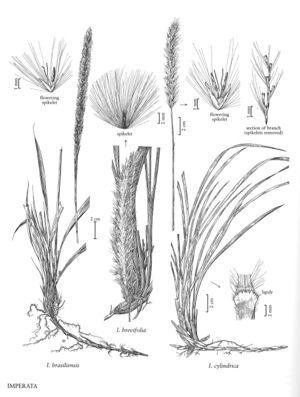Imperata cylindrica
Culms (10)30-95(217) cm. Ligules 0.2-3.5 mm; blades to 150 cm long, (1)3-11(28) mm wide, linear-lanceolate, bases narrowed to the broad midrib, often with hairs on the margins. Panicles 5.7-22.3(52) cm, narrowly cylindrical; lower branches 1-3.2(7) cm, appressed. Callus hairs 9-16 mm; glumes 2.6-5.5 mm; lower lemmas 1.4-4.5 mm; upper lemmas (0.7)1.3-2.3(3.4) mm; stamens 2, filaments not dilated at the base; anthers (1.5)2.2-4.2 mm, orange to brown; styles 0.5-3.4 mm; stigmas 2.8-5.2(8.3) mm, purple to brown. 2n = 20, 40, 60.
Distribution
Va., Tex., La., Ala., Ga., Miss., S.C., Fla., Oreg.
Discussion
Imperata cylindrica is the most variable species in the genus. Several varieties have been recognized but, although there are statistically significant differences between plants from different regions, identification to variety without knowledge of a plant's geographic origin is risky. All North American plants examined have had 2n = 20.
Imperata cylindrica is one of the world's 10 worst weeds, and is listed as a noxious weed by the U.S. Department of Agriculture. It was introduced to Alabama by 1912, and has spread considerably through the southeastern United States since then. The cultivar 'Red Baron' is diminutive and non-weedy, but individual shoots may revert to the aggressive form. Such reversion is particularly common in plants grown from tissue culture.
Selected References
None.
